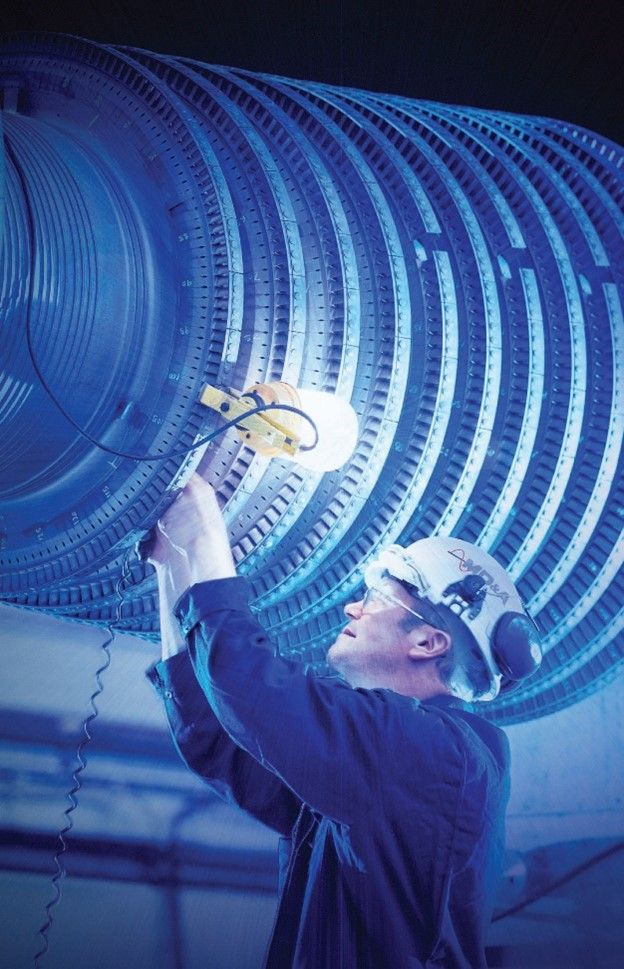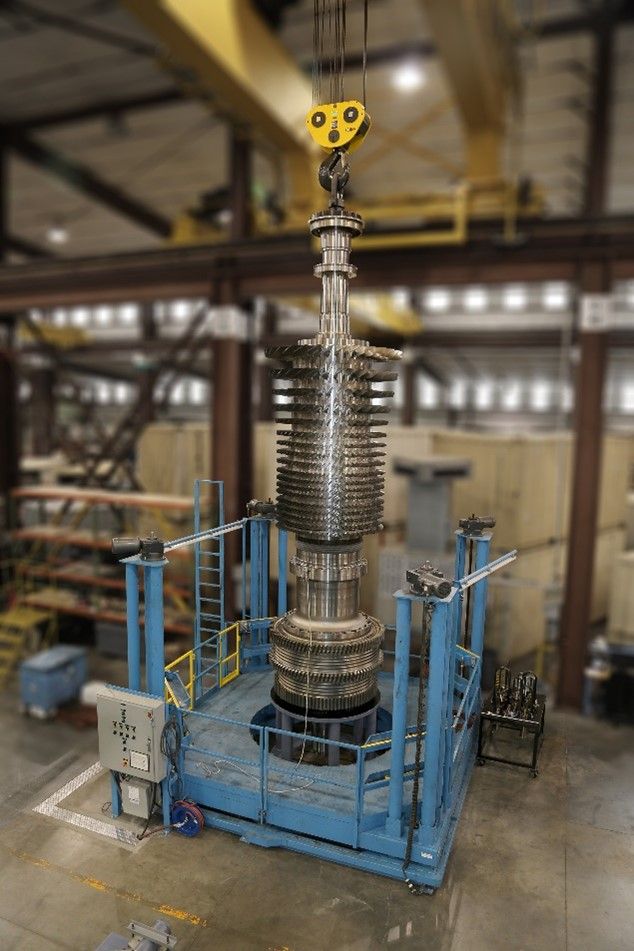Vendor Spotlight: MD&A
Servicing Turbines and Generators in the Load-Following Era
Bucket inspection of high-pressure steam turbine

Many OEMs are moving away from supporting legacy generating fleets. Yet the service needs of this equipment havenot dissipated. In fact, that equipment continues to provide grid stability and is being asked to operate in conditions for which it was not designed.
Large generating equipment, for example, is being dispatched in a load-following manner with peak demands filled by machines designed for baseload. As wind and solar generation wind down in the evening due to natural conditions, and power demand increases as a result of people arriving home, these units are asked to pick up that load. As a result, utilities are asking for different solutions to make equipment dispatchable. Maintenance remains vital so their equipment doesn’t become unsafe to operate.
“The investment to maintain reliability is different than the investment to maintain efficiency,” said Jay Eldridge, Vice President of Sales & Marketing at MD&A. “Our role as a full-service pro-vider is to help customers make good reliability and dispatchability maintenance decisions at a competitive cost.”
When equipment is old and nearing end of life, users need help in extending the life of their machines by an additional cycle until future technologies grow to the point of displacing their assets. Accordingly, Mechanical Dynamics & Analysis (MD&A) aligns itself with customer requirements and their long-term plans for assets. It provides power generators around the globe with a full-service, OEM-alternative for services, parts, and repairs for gas turbines, steam turbines, and generators. Over the last 40 years, its engineers have developed time-tested principles that produce quality repair solutions for gas and steam turbine-generator rotors and components.
Jay Eldridge, MD&A.

“We make repair recommendations based upon the owner’s intended operating plans for the unit,” said Eldridge. “Our capabilities range from steam turbine rotor and stationary component repair to liquid-cooled generator rewinds, gas turbine rotor life extension, and high-speed balance.”
MD&A provides clients with the labor, engineering, and technical experts necessary to address both planned and forced outages of most types of turbines and generators. Its capabilities range from alignment to performance testing and analysis, including control and excitation field engineering, consulting, and training. The company also supplies replacement gas and steam turbine-generator parts and components that address reliability, life extension, and capacity demands by providing retrofit and part solutions. Capabilities range from gas turbine capital parts to packing and spill strips to drop-in valve solutions.
250,000 square foot MD&A turbine-generator repair facility located in St. Louis Missouri USA

MD&A FACILITIES
The bulk of this work is done at the 250,000 square foot MD&A turbine-generator repair facility in St. Louis, Missouri. This includes gas turbine repair, steam turbine repair, generator, machining, and high-pressure valve repair. The company also has a high-speed balance facility located at the same facility in St. Louis, as well as several parts supply facilities and sites specializing in controls and fuel nozzles.
MD&A manufacturers a wide range of parts and components for GE, Siemens, Alstom steam turbines, GE 7FA & 7EA gas turbines, and 7FA and 7EA discs and wheels to support its own rotor life extension program. It can also perform reverse engineering to support turbine owners with short cycle, high quality, aftermarket parts.
“Our reverse engineering experts support everything from small consumable parts needs to full turbine section or generator replacements,” said Eldridge. “Recently, we have added to our inventory to include stator bar components, generator field retaining ring forgings and complete generator field spares to allow us to respond immediately to forced outage needs.”
RESPONDING TO INDUSTRY TRENDS
With so many turbines going through its shops, Eldridge noted several trends such as speed of outage execution becoming more vital. But the demands of the current operational climate are showing up, too, in areas such as steam turbines exhibiting eroded last stage buckets.
“Gas turbine operators have migrated from utilizing new capital components to running with brown (repaired) components,” he said. “Our engineers have observed that gas and steam turbine generators are failing more regularly, requiring both stator and field repairs/replacements to allow the units to be returned to service.”
In response to these trends, the company has developed an inventory plan that enables it to respond to emergent needs during planned and forced outages. In addition, it has developed solutions to expedite outage execution. In particular, MD&A offers “drop in” valve solutions for many types of steam turbines to allow an owner to install a valve cartridge during an outage and have a rotating spare repaired off outage/off critical path.
“We stock inventory of brown hot gas path components for GE gas turbines to support the growing trend of utilizing repaired parts rather than new,” said Eldridge. “We also stock replacement components for generators to include GE 7FH2 and 7A6 to support stator rewinds and field swaps.”
He urged owners to consult with their service providers well in advance of an outage to discuss options to respond to unexpected needs during the outage. A detailed spare parts review and stocking program should be done ahead of the outage with particular focus on any parts or equipment with long-lead items.
7FA unstack for rotor life extension at our MD&A repair.

ROTOR LIFE EXTENSION
Rotors in gas turbines produced in the late 20th and early 21st century are approaching the number of starts and hours defined by the OEM as the design service life. This recommended service life is based on many factors including: duty cycle, ambient environment, maintenance practices, and material properties. In reality, rotor end-of-life is usually governed by only a few weak-link components. The remaining components may have additional maintenance intervals of useful life remaining, either asis or with minor refurbishment.
“A comprehensive rotor inspection and end-of-life assessment can help turbine owner/operators determine what course of action to take to ensure that their rotors continue to operate safely and reliably,” said Eldridge.
MD&A rotor life extensions for GE Frame 7FA and 7EA turbines are compatible with OEM rotors and offer high performance and durability. Information needed for a rotor end-of-life assessment can be broken down into two categories: general design information and user-specific information. In the former category are such items as material properties, accurate dimensional characterization, and an understanding of failure modes. The latter category includes operating history, site conditions, location, and extent of any defects (as determined by a complete non-destructive inspection), and the expected profile of future operation. As rotor life is defined by both hours and starts, an understanding of the detrimental effects not just of cyclic operation but of extended high-temperature operation is critical to success.
“To maximize the probability of continued safe and reliable operation, weak-link components should be carefully evaluated and, if necessary, replaced,” said Eldridge. “Improvements can be made in any of several areas: materials, thermal management, manufacturing processes, and mechanical design. Any approach must balance expected effectiveness and practical considerations.” For more information, visit www. mdaturbines.com ■
